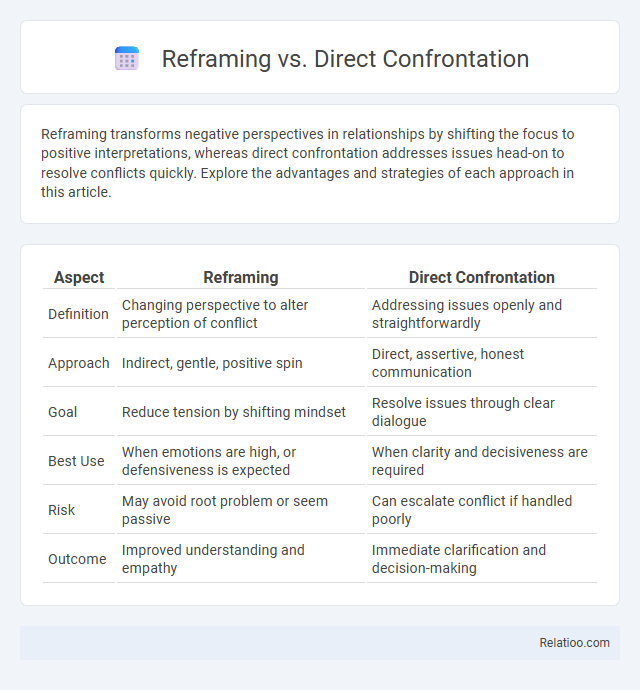Reframing transforms negative perspectives in relationships by shifting the focus to positive interpretations, whereas direct confrontation addresses issues head-on to resolve conflicts quickly. Explore the advantages and strategies of each approach in this article.
Table of Comparison
| Aspect | Reframing | Direct Confrontation |
|---|---|---|
| Definition | Changing perspective to alter perception of conflict | Addressing issues openly and straightforwardly |
| Approach | Indirect, gentle, positive spin | Direct, assertive, honest communication |
| Goal | Reduce tension by shifting mindset | Resolve issues through clear dialogue |
| Best Use | When emotions are high, or defensiveness is expected | When clarity and decisiveness are required |
| Risk | May avoid root problem or seem passive | Can escalate conflict if handled poorly |
| Outcome | Improved understanding and empathy | Immediate clarification and decision-making |
Understanding Reframing: Definition and Techniques
Reframing involves changing the way you perceive a situation to alter its meaning and emotional impact, often turning challenges into opportunities. Effective techniques include cognitive reframing, where negative thoughts are replaced with positive alternatives, and context reframing, which shifts the perspective to highlight different aspects of an event. Your ability to master reframing can lead to improved emotional resilience and more constructive conflict resolution compared to direct confrontation.
What Is Direct Confrontation? Key Characteristics
Direct confrontation involves openly addressing an issue or conflict without avoidance or ambiguity, emphasizing clear and honest communication. Key characteristics include assertiveness, a focus on the problem rather than personal attacks, and an intention to resolve misunderstandings or disagreements swiftly. This approach contrasts with reframing, which shifts perspective to reduce defensiveness and promote positive dialogue.
Psychological Foundations of Reframing
Reframing is deeply rooted in cognitive-behavioral psychology, emphasizing the alteration of perception to change emotional responses and behaviors effectively. Unlike direct confrontation, which challenges beliefs head-on and can trigger defensiveness, reframing gently shifts your viewpoint to foster insight and emotional resilience. This psychological foundation leverages the brain's ability to reinterpret experiences, promoting adaptive thinking patterns and reducing cognitive distortions.
The Impact of Direct Confrontation on Communication
Direct confrontation in communication often triggers defensive responses, hindering effective dialogue and problem resolution. Unlike reframing, which invites open-mindedness by presenting alternative perspectives, direct confrontation can escalate conflicts and reduce mutual understanding. The impact of direct confrontation typically results in strained relationships and decreased collaboration, emphasizing the importance of strategic communication approaches.
Benefits of Reframing in Conflict Resolution
Reframing in conflict resolution transforms negative perspectives into positive viewpoints, promoting empathy and understanding between parties. This approach reduces defensiveness and facilitates collaborative problem-solving, improving communication and emotional connections. Your ability to reframe challenges often leads to more constructive outcomes compared to direct confrontation, which can escalate tensions.
When Does Direct Confrontation Work Best?
Direct confrontation works best in situations where clear communication is essential to address urgent issues or resolve conflicts quickly, especially when the parties involved are open to honest dialogue. You benefit from direct confrontation when emotions are manageable, and the goal is to establish boundaries or correct misunderstandings without ambiguity. This approach is most effective in professional settings or personal relationships requiring immediate clarity and decisive action.
Common Pitfalls in Reframing and How to Avoid Them
Common pitfalls in reframing include misinterpreting the original context, applying overly generic perspectives, and ignoring emotional nuances, which can lead to misunderstandings and resistance. Avoid these by thoroughly understanding the situation, tailoring reframes to specific emotional and cognitive frames, and actively listening to the concerns involved. Emphasizing clarity, empathy, and relevance ensures reframing effectively shifts perceptions without alienating the audience.
Navigating Emotional Reactions: Reframing vs Direct Confrontation
Navigating emotional reactions involves understanding that reframing helps You shift perspective by transforming negative emotions into constructive insights, reducing defensiveness and promoting empathy. Direct confrontation, while addressing issues head-on, may escalate emotional responses if not managed carefully, risking increased tension or resistance. Balancing reframing techniques with selective direct confrontation fosters effective communication by validating feelings while encouraging resolution.
Choosing the Right Approach: Factors to Consider
Choosing the right approach between reframing and direct confrontation depends on factors such as the nature of the conflict, the relationship dynamics, and desired outcomes. Reframing works best when aiming to shift perspectives and reduce defensiveness, particularly in collaborative or ongoing relationships. Direct confrontation is more effective for resolving clear-cut issues quickly but may escalate tension if emotional stakes are high or trust is low.
Practical Examples: Reframing and Direct Confrontation in Action
Reframing transforms negative situations into positive opportunities by shifting your perspective, such as viewing a job rejection as a chance to find a better fit. Direct confrontation involves addressing an issue head-on, like calmly expressing dissatisfaction about a missed deadline to improve future communication. You can combine these approaches by first reframing your mindset to reduce emotional intensity, then directly confronting the issue with clarity and confidence for effective conflict resolution.

Infographic: Reframing vs Direct Confrontation
 relatioo.com
relatioo.com